A walk in the Sierra Minera
Roxanne is back again, with something new for you to read:
I’ve been very busy lately. I have been building a wall around the edge of my dead hamster’s grave. My hamster – Chicita – died a year ago. And I’ve only just got round to building the wall round her grave… I’ve been planting seeds round the grave, mostly from the hamster’s food. (A year – and I haven’t got round to throwing away the hamsters food!) And I’ve been watering the grave, and I’ve been attempting to weed out the weakest seeds so that the strongest can have room to grow. And I’ve also been tidying my cabin. And I’ve been non-stop cleaning my animal’s cages – a bit like cleaning the Forth bridge – by the time you have done the last one the first needs doing again! And, of course, when I do find a second to spare, as likely as not – or actually a lot more likely than not – I find that the internet is off. Now I suppose we can get on with the story…
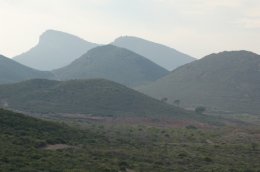 One day our friend Javier, who is a nature warden, came to us and said that he had brought a new house. “And it’s full of old junk!” he joked. Javier and us spend a lot of time giving each other “junk”.
One day our friend Javier, who is a nature warden, came to us and said that he had brought a new house. “And it’s full of old junk!” he joked. Javier and us spend a lot of time giving each other “junk”.
“Why don’t you come round on Monday and see if you want anything?” Javier said. We assured Javier that we would come, and, in gratitude we begged to him to accept two grinders and two radios.
“We don’t need them,” Daddy said to him. “We have two more grinders!”
“And two more radios!” Mummy muttered.
When we arrived at Javier’s house we were welcomed by a large but good natured alsatian.
“Niebla!” Javier shouted to the dog, as soon as he emerged from the house. “Ven aqui! Ven aqui! Niebla! VEN AQUI!” Niebla, who had decided to be temporarily deaf, continued roughly but good naturedly welcoming Poppy into her territory.
Javier led us into a large shed, were he immediately presented us with a piece of wood as big as himself. In revenge we gave him a hifi, two speakers, a guitar, and a toy hot air balloon. He accepted them, but firmly refused when it came to three pairs of roller-skates.
Apparently Javier had not yet got the key for his new house. So he could not show us his “junk”. Instead, he said he would take us for a walk in the Sierra Minera. Poppy and Niebla were newly made friends, and we were doubtful about whether the two would walk together without fighting. But – “Don’t worry!” Javier said. “Neibla wouldn’t hurt Poppy, and any way, she will be miles away, hunting rabbits.” The latter proved to be wrong, for with Poppy around Niebla would not stray away from Javier!
Now, I often wonder about grown-ups and whether they are right in the head. We were going for a long, hot, dusty walk – so they made me wear walking boots! Thick walking boots, with thick socks inside.
“Don’t forget your jumper,” said Mummy.
We set off up the track, and soon my feet were boiling!
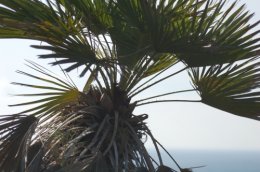 We walked away from the house and the road, along a valley. We came to a flowering rosemary bush. It had lovely trumpet shaped flowers on it. It was not the same as the one that is usually growing in English gardens. There were also lots of other plants, including some dwarf palm trees with red berries, and a few stone pines.
We walked away from the house and the road, along a valley. We came to a flowering rosemary bush. It had lovely trumpet shaped flowers on it. It was not the same as the one that is usually growing in English gardens. There were also lots of other plants, including some dwarf palm trees with red berries, and a few stone pines.
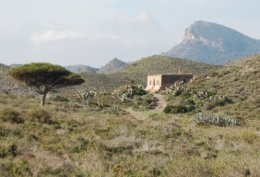 The path climbed slowly and we came to a little rise, and it was then that Mummy saw “her house”. It was an old stone house, which looked as if it should long since have fallen down, and it had a rough, sloping roof, filled with cracks and gaps.
The path climbed slowly and we came to a little rise, and it was then that Mummy saw “her house”. It was an old stone house, which looked as if it should long since have fallen down, and it had a rough, sloping roof, filled with cracks and gaps.
“Ah!” cried Mummy. “Es mi casa!” It’s my house! Javier laughed. Apparently the house had belonged to his father’s grandmother’s sister, and was still owned by some distant relations.
“We’ll go and see it,” he said.
“It’s just my sort of house,” Mummy went on. “No road, no town…”
“No electricity, no water,” said Javier.
“Oh, I don’t mind that,” said Mummy. “It’s like a boat in an ocean. It’s all alone, with a lovely view.”
As we approached the house we came across an old dried up well. We also noticed other snags. The door was splintered and broken in half, the roof had been leaking, and the floor was littered with broken furniture.
“Ah!” said Javier, sadly. “Immigrants. The immigrants from Morocco come ashore on the beach nearby. They must have found this place and decided it was a good place to hide”.
Mummy still thought it was a wonderful place. There were flowers growing near the door that someone had planted, and there was a huge cone-shaped stone which used to be dragged around by a mule to thresh the grain. Mummy liked thinking about that, but she didn’t like thinking about immigrants coming past the door in the night, like the smugglers in the song, so she stopped saying she wanted to live there.
I found a tiny house-leek and I dug it up and carried it, to grow in a pot on the boat.
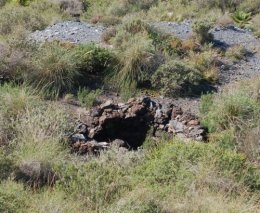 We went back, past the well where Javier’s great great aunt used to fetch water, and past the stone pine where she used to sit, and past the sisal plants that she may have used to make rope, and we carried on with our walk. We went down from the rise, heading towards the sea along a little valley. In the valley there were a few very old mines. Javier said that they were Roman mines, so Mummy got very excited again and started picturing Roman centurions marching along the path. It is because of the mines that these hills are called the Sierra Minera – the Mining Mountains. There was silver and lead in the rocks, and the Romans came all the way from Italy to get it.
We went back, past the well where Javier’s great great aunt used to fetch water, and past the stone pine where she used to sit, and past the sisal plants that she may have used to make rope, and we carried on with our walk. We went down from the rise, heading towards the sea along a little valley. In the valley there were a few very old mines. Javier said that they were Roman mines, so Mummy got very excited again and started picturing Roman centurions marching along the path. It is because of the mines that these hills are called the Sierra Minera – the Mining Mountains. There was silver and lead in the rocks, and the Romans came all the way from Italy to get it.
We went on down towards the sea. Then, before we reached the sea, we crossed the bottom of the valley. There was supposed to be a bridge over the rambla in the bottom of the valley, but it had been carried away in a rainstorm, about a month before, so we had to scramble down and up. Except Poppy, who jumped across.
We walked up the far side of the valley, still heading towards the sea. We came to a place where the rocks were covered in clothes.
“Immigrants again,” said Javier. The immigrants come across the sea from Africa. They come here because they want to get rich and live a better life, but they don’t have visas so they can’t come and land in the port. They come across on calm nights in tiny boats.
“They get very wet landing their boats on the beach,” said Javier, “So they drop their clothes and change as they run.”
We walked a little further and he pointed down at the beach. There were two blue and white dinghies lying half buried in the sand.
“Those are the immigrants’ boats,” Javier said.
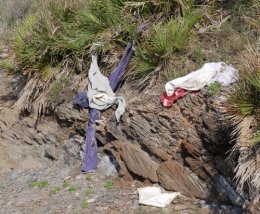 [A note from the editor: Roughly 10 % of the Spanish population is immigrant – and those figures only show the people who arrived here legally and who are “on the books”. Every night, when the weather is fit, hundreds of Africans attempt the crossing from Morocco. Sometimes they even come by day; last summer several boatloads of Moroccans arrived off La Manga and managed to land and disperse themselves amongst the tourists thronging the beach! Meanwhile, hundreds of other would-be immigrants have drowned during their attempt to cross the Mediterranean in unseaworthy boats. It is said that 100,000 illegal immigrants were turned back from Spain this past year – but for every person who is turned back, another is successful. Spanish attitudes towards the problem vary considerably. When we asked our friend if he was going to report the fact that his cousin’s house was being used by the illegal immigrants, he said, “Those poor people need all the help they can get.”]
[A note from the editor: Roughly 10 % of the Spanish population is immigrant – and those figures only show the people who arrived here legally and who are “on the books”. Every night, when the weather is fit, hundreds of Africans attempt the crossing from Morocco. Sometimes they even come by day; last summer several boatloads of Moroccans arrived off La Manga and managed to land and disperse themselves amongst the tourists thronging the beach! Meanwhile, hundreds of other would-be immigrants have drowned during their attempt to cross the Mediterranean in unseaworthy boats. It is said that 100,000 illegal immigrants were turned back from Spain this past year – but for every person who is turned back, another is successful. Spanish attitudes towards the problem vary considerably. When we asked our friend if he was going to report the fact that his cousin’s house was being used by the illegal immigrants, he said, “Those poor people need all the help they can get.”]
Now the path followed the coast. We were high above the sea. There were hardly any plants and this was because of the mining. The plants have not yet grown back because there is no soil for them to grow in. It is all rocks and stones. The Romans were not the only ones who mined here. The Romans made tunnels, but more recently people dug away the hillside to get at the silver and lead. Then they washed the soil on the mountainside. The waste soil made huge coloured piles and they are still there. We saw some of the wells that they dug to get the water to wash the soil.
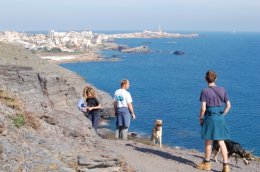 After quite a long way we came around a headland, and there was the village of Cabo de Palos ahead of us in the distance. We continued along the path and it went down from the cliff towards a beach. Then it got lost in some thorn bushes so we floundered around for a while. When we came out of the bushes we found that the path was buried. Mummy called it a silver beach. It was waste that had washed down from a Roman mine and it was silvery, but it was probably lead ore rather than silver. Javier said it had all washed down in the rain and destroyed the path, so we had to go home a different way.
After quite a long way we came around a headland, and there was the village of Cabo de Palos ahead of us in the distance. We continued along the path and it went down from the cliff towards a beach. Then it got lost in some thorn bushes so we floundered around for a while. When we came out of the bushes we found that the path was buried. Mummy called it a silver beach. It was waste that had washed down from a Roman mine and it was silvery, but it was probably lead ore rather than silver. Javier said it had all washed down in the rain and destroyed the path, so we had to go home a different way.
On the way back Mummy saw some birds soaring in the sky and Javier said they were eagles. They were black and white, but she only saw them for a minute before they went behind a hill. We can’t find them in the bird book. We also saw kestrels and Sardinian warblers.
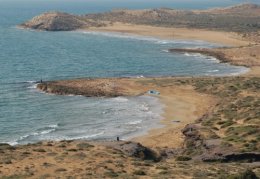 When we got back to Javier’s house we went into his garden to pick tomatoes for a paella. As I pulled one tomato from a plant I saw that it was dried up and hollow, and poking its head out of a hole was a fire bug! He scuttled away. We had a nice paella without him.
When we got back to Javier’s house we went into his garden to pick tomatoes for a paella. As I pulled one tomato from a plant I saw that it was dried up and hollow, and poking its head out of a hole was a fire bug! He scuttled away. We had a nice paella without him.

Hey Roxanne,
Yet another great trip report… You just have to come back for a visit to Grazalema. We have lots more walks to show you and i want to show you the water powered flour mill that my friend has repaired….
By the way, you should, post more on our iberianatureforum!
xxx
Clive
Thanx for the walk – I’m glad you were wearing the right kind of walking boots – and for the update on your lessons in life. Javier sounds like a nice guy – está empezando a caerme bién.
The “Admiral” is very keen to go and see the water mill. She’s fallen in love with wind and water powered machines, including wind and water powered mills, and there isn’t a wind mill in Spain that she isn’t dying to see. But she’s never seen a horizontal water mill! I don’t now if we’ve got time to come and visit you at the moment – we’re all frantically building the boat so we can rush of and potter about in the Atlantic ocean!
Yes, Javier is “a nice guy”. In fact he’s one of our best friends here in La Manga.
Ship’s snail / Naturalist